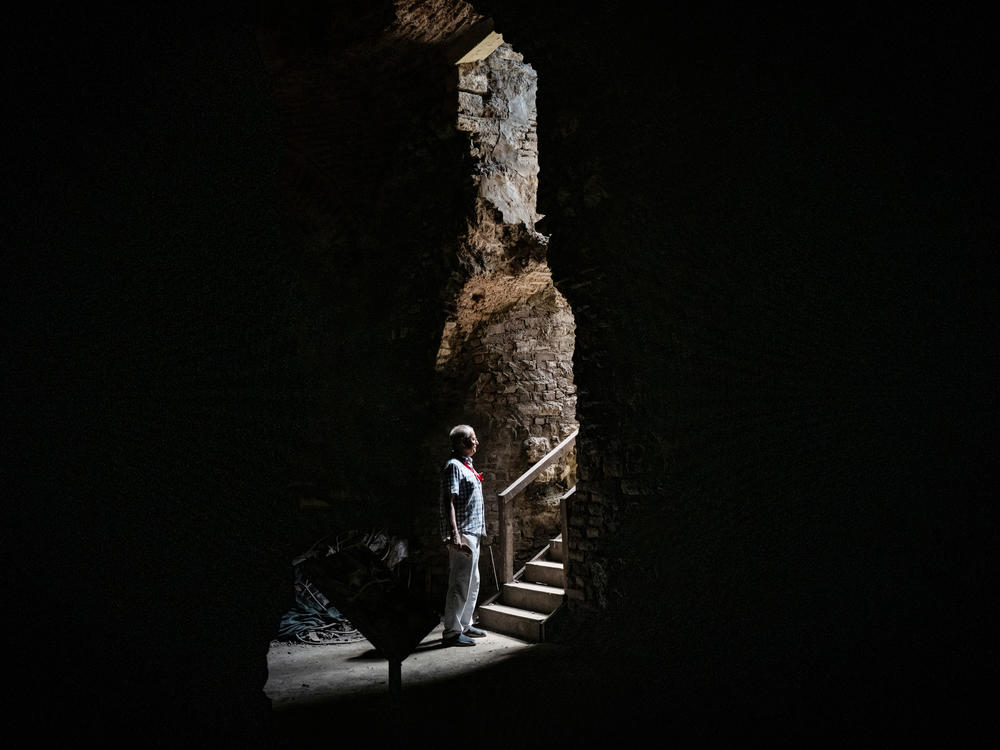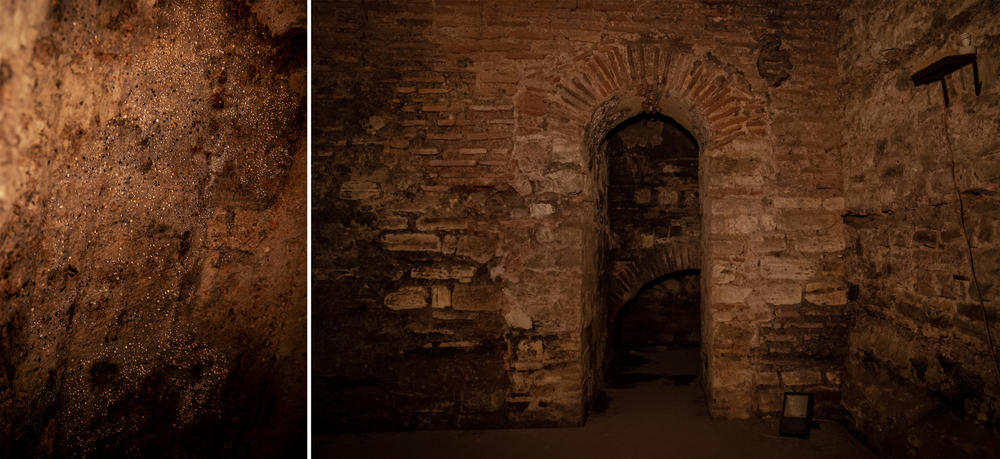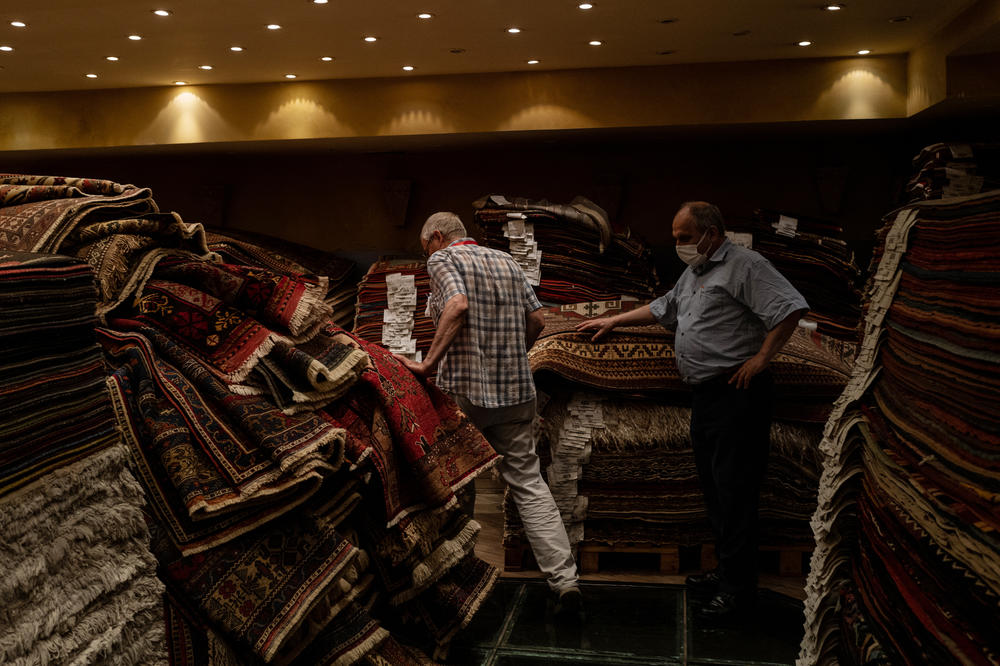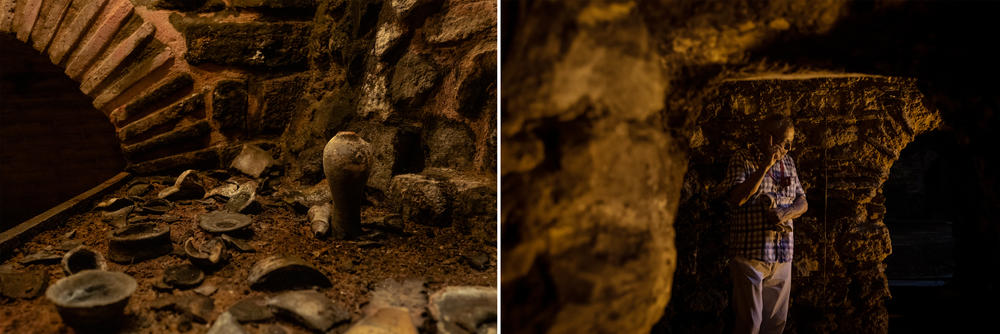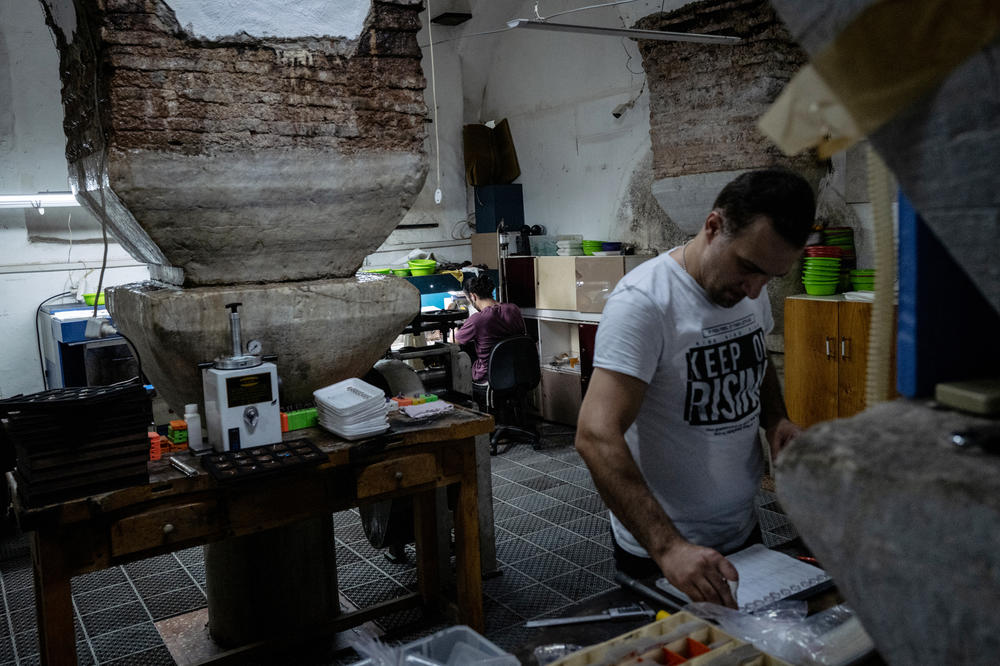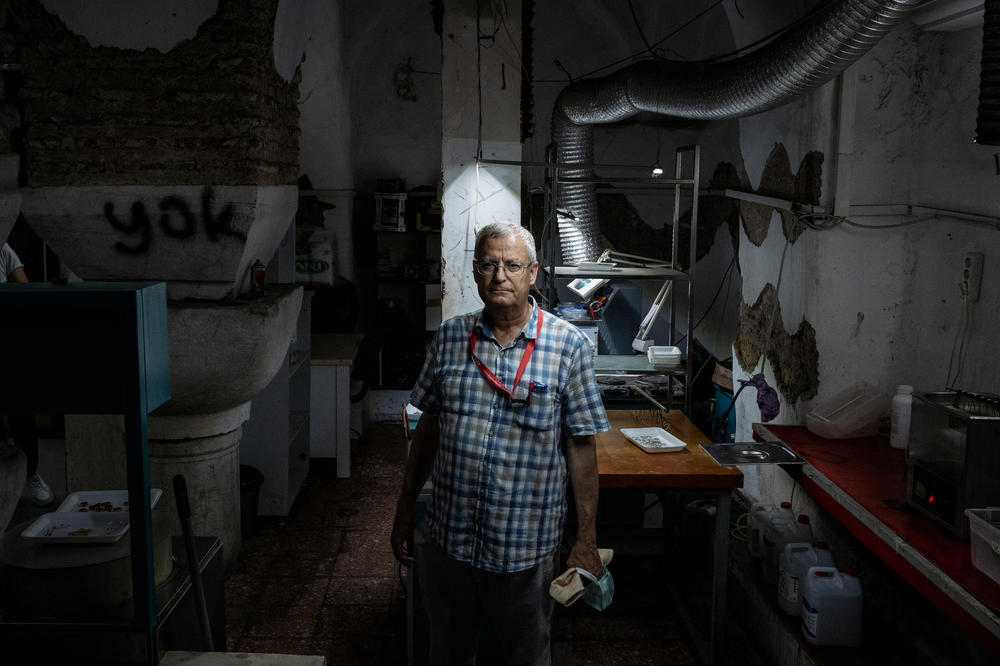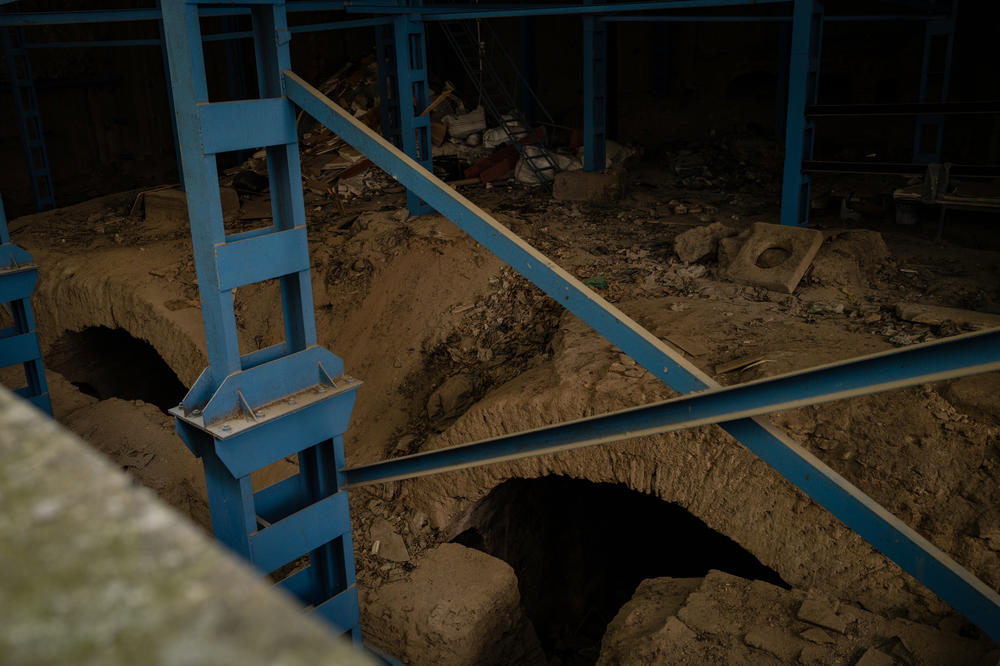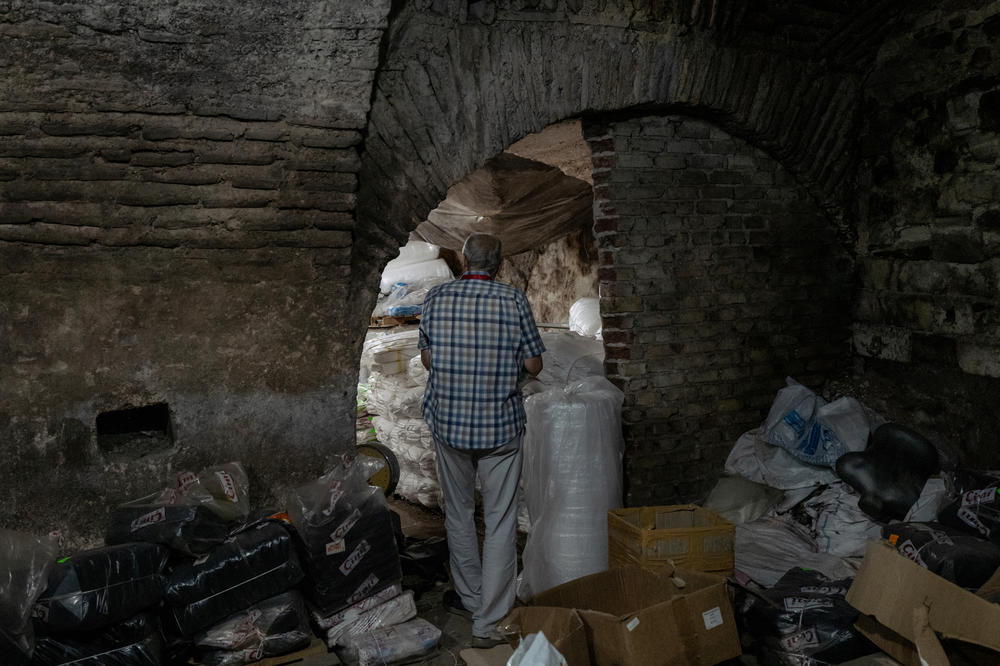Section Branding
Header Content
Beneath Istanbul, Archaeologists Explore An Ancient City's Byzantine Basements
Primary Content
The winding streets of old Istanbul are an overlapping cacophony of seagulls, ship horns and vendors of colorful fresh fruit. Shady fig trees cluster near crumbling Byzantine walls and sweeping Ottoman palaces, remnants of the empires that conquered and lost this strategic point on the Bosporus Strait, which formed the seat of the Eastern Roman Empire.
Underneath it all is an ancient world that's almost invisible, unless you know where to look.
"Can you imagine my excitement when I saw this for the first time?" exclaims archaeologist Ferudun Ozgumus, as he leads the way down a rickety wooden staircase into a cavernous structure deep beneath a carpet shop. "It was full of debris as far as that corner of the arch," he says, pointing across the space to a point 15 feet overhead. "We were crawling!"
For more than 20 years, Ozgumus has knocked on the doors of Istanbul's oldest neighborhoods and asked to see the basement. At 64, the Istanbul University professor is one of the first archaeologists in Turkey devoted to studying the city's underground spaces. He has identified more than 300 sites, and he knows there are hundreds more.
As soon as you step inside the corridor of the carpet shop basement, the temperature drops. Arches, at least 20 feet high, are evenly spaced through the structure. Water drips from the ceiling, and as you look up, you see swirls of bricks — thin and rust-colored, alternating with thick stripes of mortar.
"The thickness of the bricks, the thickness of the mortar between the bricks and the color all tell me the date of the structure," Ozgumus explains. "You can see this arch, it's hewn stones, cut stones. This arch is older. I'm sure that this is from the 2nd century A.D."
This particular site, Ozgumus believes, may be related to a sprawling palace built by Constantine the Great, the 4th century Roman emperor and founder of ancient Constantinople. But it's hard to know for sure. Many Byzantine-era buildings that are mentioned in archival documents have been lost to history, such as Constantine's famous palace reception hall. No one has ever found it.
"We have a lot of literary sources coming from the late-Roman time, but archaeological data doesn't match," Ozgumus says.
Ozgumus' working theory, based on the bricks and the shop's location, is that this structure may have been a storage basement underneath that palace reception hall. But this idea can only be confirmed by additional excavations.
"It's like another world, another city"
Throughout Istanbul, there are clues to how residents of the Byzantine capital lived, worked in and built their city. These blend in with the current surroundings: The ruins of an ancient Roman bathhouse frame the boiler room of a modern office building. A 6th century cistern with blinding-white columns serves as a jewelers' workshop, with machinery to etch out silver necklaces and rings. ("The ventilation isn't great," says the owner, "but it stays warm in the winter and cool in the summer.") And the shell of a small church — reachable by ladder — sits beneath the basement of a hookah bar.
After Ozgumus completed a 13-year archeological survey of Istanbul's historic peninsula in 2010, younger scholars have continued his work, adding hundreds of sites to the public record.
These sites form the basis of a small but growing line of underground tours, in which visitors can navigate narrow passages to see ancient brickwork, cisterns and frescoes from long-forgotten churches.
"There's no easy access to underground structures. They're privately owned, and you need a network," said Yasin Karabacak, an author and tour guide who shares his finds on social media as the "Hidden Face of Istanbul."
"Everyone can go to the Hagia Sophia. But when you open a door to the underground... you feel special, like it's only for you," Karabacak says. "It's like another world, another city."
The tunnels beneath Istanbul aren't all mysterious
There is no shortage of mythology surrounding Istanbul's underground world, said to be full of secret tunnels. It's believed that an emperor had secret tunnels built from his palace to both the Hagia Sophia and the Hippodrome (now Sultanahmet Square) so that he and his entourage could appear in public without entering the street.
When Christian crusaders sacked Constantinople during the Fourth Crusade in 1204, several artifacts from the Hagia Sophia went missing. It would be logical that the church's monks could have hidden Christian relics in these secret tunnels, if they existed. But they have never been found.
Some tunnels — like those for the cleaning crews in the Ottoman-built aqueducts — simply served mundane purposes, Karabacak says.
"So not all tunnels are secret or have a secret function. They have a very basic function like cleaning, maintenance," he says.
Istanbul's Byzantine basement surfeit survives in part thanks to a 1980s cultural heritage code that allows people who find something ancient on their property to keep it, without worrying that the government will seize it.
"Thanks to this new law, a lot of historical things were protected by the locals in Istanbul," Ozgumus says. "Before, they were destroying it."
For some, the Roman ruins have attracted tourists and been a boon. The owner of one carpet shop, finding a cistern underneath it, converted the site into a small museum devoted to Constantinople's ancient Hippodrome. Another built his shop's foundation around a fallen column simply because it was too heavy to move.
Others still fear losing their property or having renovations delayed by historical surveys. Sometimes construction can be held up because of significant archeological finds. So they keep their property's ancient sites hidden, Ozgumus says.
Byzantine marvels include an earthquake-proof water storage system
Byzantine stonemasons were experts at building underground. They created an extensive system of cisterns to store water pulled in through aqueducts, and large basements under public buildings to provide temperature-controlled storage.
Kerim Altug, an archaeologist and architectural historian who works with the Istanbul Metropolitan Municipality, noticed that the cisterns were built with techniques that helped the city's water supply withstand earthquakes.
"The model consists of four columns, each connected with arches. Each square bay creates a cistern. And each is connected to another by wooden tie beams," Altug said. "It moves uniformly during the earthquake and never collapses."
Altug has mapped the location of 158 Byzantine cisterns, and believes there were thousands in ancient Constantinople.
"We don't know where we are on this work, because there are many other cisterns waiting to be discovered," Altug said. "There are no systematic archeological excavations. Most are rescue excavations for construction projects."
When the Ottomans arrived, it made sense for then to build over and reuse Byzantine structures, says historian Arzu Ulas, rather than demolishing them and starting from scratch.
"Materials used in the Byzantine empire were hard to find in wartime," the Istanbul University graduate student says. "It was very costly, and the Byzantine structures were very strong."
The Ottomans expanded and improved Constantinople's water system. They sometimes converted cisterns into silk weaving workshops and storage for fresh produce. Later, some substructures fell into disrepair or were used for illegal activities such as smuggling, Ulas says. Under some mosques, she's found corridors filled with water and animal bones.
"When we found [the corridors], they were usually in a very bad state," Ulas says. "They weren't taken care of after the 19th century, when the empire started to weaken."
Not everything should be excavated
In Istanbul's Fatih district, a balcony behind a wholesale leather distributor overlooks stone arches that Ferudun Ozgumus believes were built as part of a storage basement under a stately home on the Forum of Theodosius, Constantinople's main square. He believes this is a 6th century structure, based on its column capitals dating to the era of the Emperor Justinian.
Ozgumus points out two rectangular voids in the stone, the remnants of an ancient heating system which forced warm air through the belly of a building and into adjoining rooms.
These arches have survived centuries of earthquakes, fires and rapid urban development. Even today, they're still supporting the weight of the world above.
But in a jarring juxtaposition, 30-foot blue metal stilts are bolted into the stones, holding up the floor of a prefabricated shopping mall. A hatch in the mall's floor is used to dump trash — takeout boxes, scraps of wood, even a plastic store mannequin — onto the Byzantine structure below.
"Look at this. It's a shame on us," Ozgumus says. "In its heyday, it was beautiful."
It's a good example, he says, of why not all of Istanbul's underworld should be excavated. Too many archeological excavations were abandoned after the work was done, leaving sites vulnerable to developers.
"Those substructures are giving us the layout of the original Istanbul, from the time of the 4th century," Ozgumus says. "We're in the heart of the city now."
If you don't have the financing and a plan to preserve it, he believes, you should keep it in the ground.
Copyright 2021 NPR. To see more, visit https://www.npr.org.
